Content |
|---|
History
The Hellenic Hound has ancient origins, since their ancestors were already present ago 3.000 years in the Peloponnese Peninsula in southern Greece. These animals with their remarkable sense of smell were then known as "Lakonikoi Kynes.", which can be translated as the "Laconian hunting dog".
They spread overland to the Balkan Mountains, where they crossed with the local dogs. At the same time, Greek sailors often took them on their adventures, which allowed them to leave their mark in many areas of the Mediterranean, where various crossbreeds with native dogs gave rise to many new breeds of hunting dogs, as the Beagle.
Few races were introduced in the isolated mountains of southern Greece and thus few crosses were made.. The breed remained unchanged for centuries, which explains why its modern appearance is close to what it had in antiquity. But, there is a big difference in their fur: often tricolor in the past, now it must be black and tan. Tricolor individuals still exist, but they are not recognized by the standards and therefore cannot be officially considered as Hellenic Hound.
Numerous writings dating from ancient Greece mention that this dog has unmatched qualities for hunting in the garrigue and in the arid and difficult terrain of the Peloponnese.. Their exceptional sense of smell and their ability to return rabbits to their families explain the success they have always had in the region. It was also used to attack large game animals (deer, boars…), as evidenced by some frescoes and ceramics dating from almost 2000 years.
Some say these dogs were also used by the military, but it seems likely that it is a confusion with the "molossoids", whose size was much more impressive. On the other hand, there is evidence that in recent conflicts with Turkey they were used as messenger dogs.
The Fédération Cynologique Internationale (FCI), that federates the national organizations of some 100 countries, recognized the Hellenic Hound in 1959. It wasn't until almost 50 years later, in 2006 to be precise, what other major canine organization, the United Kennel Club (UKC) of the United States, he did the same.
It cannot be said that they had many emulators. In fact, its rarity means that few other institutions have done so. In particular, the Hellenic Hound It is not recognized by the American Kennel Club (AKC), nor for him British Kennel Club (KC), nor for him Canadian Kennel Club (CCC).
Photo: Hellinikos Ichnilatis, as well: Griechische Brackeby Georging, CC BY-SA 3.0, via Wikimedia Commons
Physical characteristics «Hellenic hound»
The Hellenic Hound are size medium, with a vigorous and powerful overall appearance.
His body is rectangular, its length is a 10% longer than his height at the withers. Muscular, with a straight back and a well developed chest, rests on powerful and robust legs that end in rounded legs. The tail is thick, rather short and set high. Can be worn as a saber when alert.
His head is well proportioned, with a slightly flat skull and a slightly pronounced stop. The ears are of medium length, falls along the cheeks and has rounded tips. Brown eyes express intelligence and alertness. As for the muzzle, its length is equal to that of the skull, and ends with a very black nose.
The Hellenic Hound they do not have undercoat, only a very short surface layer, dense and hard. The only authorized coat color is black and brown., possibly with a small white patch on the chest. The tricolor individuals (black, fire and white) were common in the past, but now they are rare, are not recognized by the breed standard and are not at all sought after.
Last, sexual dimorphism is little marked in this breed, since the male is on average slightly larger than the female.
HEIGHT AND WEIGHT :
Height to the cross: Males: 47-55 cm., females: 45-53 cm..
Tolerance of more or less 2 cm..
Weight: Of 17 to 20 kg.
Character and aptitudes «Hellenic hound»
The Hellenic Hound is happy, and for him life is a game that should not be taken seriously and should be enjoyed. Is affectionate, loyal and close to his family if they provide him with everything he needs, but is not particularly demanding in terms of care and can even be extremely independent.
He gets along very well with children who have learned to behave respectfully towards him: they are wonderful companions for him, and vice versa. On the other hand, his patience quickly reaches its limit with younger children. In any case, regardless of race, a dog should never be left alone with a young child without adult supervision.
As for the strangers, he doesn't especially like them, and is not deprived of making you feel barking when they approach. But, is not aggressive and does not attack if not provoked.
On the other hand, the fact that he has been used to hunting in packs for centuries explains why he generally gets along very well with his hunting companions, whether they share your home or strangers you meet on a walk. On the other hand, his predatory instinct leads him to relentlessly chase other animals; cohabitation with a cat should be avoided, a rodent or a bird, since it would have every chance of running out.
It also, the Hellenic Hound need a lot of exercise and feel useful. If you don't have the opportunity to exercise as you wish, you can destroy what happens under your nose in the garden or in the house, and possibly even find a way to escape to find a life that suits you best.
His favorite activity is definitely hunting, allowing you to make use of your exceptional talent and athletic qualities, but a brisk walk for an hour a day can substitute for keeping busy, as long as you also get a chance to spend some time alone. Its endurance also makes it perfectly capable of accompanying a master athlete on long walks., bike rides or running sessions.
But, it is advisable to always keep it on a leash when walking, since the souvenir orders, that are perfectly assimilated in the garden, can suddenly become ineffective once in nature, for example if you have sniffed the trail of a rabbit. This can be dangerous not only for the surrounding animals, but also for himself. An alternative way to allow him to run at will in isolated areas is to equip him with a GPS collar: this allows you to know where you are at all times, and therefore be successful in his recovery if he leaves when his master asks him in vain to return.
In fact, it must be said that the Hellenic Hound is at least as independent and stubborn as intelligent. Used for centuries to hunt without instructions from his master, you don't need anyone to tell you what to do, and he's not one of those who listen if he doesn't feel like it. This makes it very difficult to educate, and even theoretically well anchored commands can be ignored at any time, especially when his hunting instinct kicks in.
It also, is far from motivated by dog ​​sports. Those who dream of participating in flyball competitions, agility or obedience with his companion would do better to resort to another dog. The only discipline that may interest you and allow you to exercise your talents is tracking..
It also, its need for space and activity makes it completely unsuitable for apartment living, or even in a residential area. You need access to a large piece of land where you can run the 24 hours of the day and lead an active life. But, for the safety of the animal, as well as for the safety of neighborhood cats or other small animals that may pass by, better to have a good fence that prevents you from running blindly behind anything you might consider prey.
Finally, this breed is distinguished by its particularly loud barking, that wake up the whole neighborhood when a stranger passes by. This makes him a formidable alert dog., even a watchdog, since any malicious person would soon flee before so much noise.
«Hellenic Hound» Education
Like any other breed of dog, the Hellenic Hound benefits from socialization that begins at an early age and continues for many months. Allows you to get acquainted with the people who will be part of your life (friends, neighbors, postman, veterinary, etc.) but also get used to regularly meeting strangers or co-workers, as well as to face all kinds of stimuli (noises, smells, etc.) in a wide variety of places. All of this helps to gradually turn him into a balanced adult who is comfortable in all circumstances..
But, socialization is just one aspect of education, and train a Hellenic Hound it's not easy at all. Must face an experienced teacher, able to show authority, but above all capable of earning their respect by positioning themselves as a reliable leader, able to respond to your different needs. He usually does what he pleases, and although the controls are perfectly acquired, his instinct as a tracker and hunter tends to take precedence over his education, to the great despair of his family.
This in no way means that rules should not be established, since they are necessary for any dog. So that he is at least clear about what is expected of him (although I do not always comply), must be applied consistently by all family members, and not change over time.
in addition, the fact that sometimes he forgets to obey does not mean that it does not make sense to teach him commands like the basic ones (sit down, lie, etc.) or remember.
Walking on a leash is also one of the indispensable teachings, so you don't have to do whatever you like during the walks, that can sometimes turn into a nightmare.
It goes without saying that traditional training methods are doomed to fail with this independent dog.. On the other hand, positive reinforcement, by allowing you to find an interest in doing a task that you would otherwise find, already much more likely to work.
Health and care «Hellenic hound»
The Hellenic Hound they are very robust, as evidenced by their respectable life expectancy and the short list of diseases to which they are predisposed.
Their lack of undercoat and short coat make them comfortable in hot climates (for example, the mediterranean guy), but are not suitable for cold or humid regions. This is especially true as he spends most of his time outdoors..
The main health problems that can affect the Hellenic Hound are ...:
- Hip Dysplasia, a joint deformity that may be favored by a hereditary predisposition, that causes more or less important mobility problems;
- dilation-torsion of the stomach, often due to too rapid ingestion of large amounts of food, that occurs when this organ folds in on itself, blocking the evacuation of gases and interrupting blood circulation. Without the prompt intervention of a veterinarian, It is fatal;
- ear infections and other ear infections, as in any dog ​​with hanging ears, because this morphological characteristic facilitates the accumulation of dirt.
Last, the very active lifestyle of Hellenic Hound and its use for hunting makes it particularly prone to fractures, cuts and scrapes, that often go hand in hand with the great outdoors.
Using a serious breeder is the best way to maximize your chances of adopting a puppy that is healthy and has benefited from quality socialization from its first weeks.. Must be able to present a certificate of good health signed by a veterinarian, details of the vaccinations the puppy has been given and the results of genetic tests performed on the parents, if you were careful to make sure they did not carry the gene that promotes hip dysplasia before raising them.
Once adopted, it is important that the puppy can rest at will throughout its growth phase, which can last up to 18 or even 24 months, but also do not do too intense or prolonged activities during the growth phase. Too much stress on still fragile bones and joints could not only lead to short-term injury, but also potentially cause irreversible damage.
Last, one of the basic rules to keep your dog healthy throughout his life is to take him to the vet at least once a year for a complete checkup. This allows us to detect possible health problems, sometimes even before the first symptoms appear, and be able to treat them in the best possible conditions. It also, this appointment is also an opportunity for the necessary vaccines to be withdrawn.
At the same time, it is the owner's responsibility to ensure that their pet is always protected against parasites, renewing your antiparasitic treatments whenever necessary. This is particularly important for dogs that spend a lot of time outdoors..
Maintenance and grooming «Hellenic hound»
The maintenance of Hellenic Hound it's extremely simple, and this is especially true of their fur. A quick brushing every week is more than enough, given the lack of undercoat, the length of the hair and the fact that the Hellenic Hound loses very little hair, even during the molting period.
These characteristics also make it very suitable for a person allergic to dogs., although there is no breed of dog 100% hypoallergenic. This explains why it is always essential for that person to spend a few hours in the company of the animal being considered for adoption to ensure that there is no allergic reaction..
It also, normally it is not necessary to bathe Hellenic Hound, unless, of course, has become particularly dirty. If this is the case, it is necessary to use a mild shampoo designed specifically for dogs, as this can damage the skin.
The floppy ears are probably the area that requires the most attention., since its shape favors the accumulation of dirt, which can lead to the development of infections. To prevent this from happening, should be wiped weekly with a clean cloth and dried after swimming or any long period of time in a humid environment.
To complete the weekly grooming session, it is advisable to check that the eyes are clean, and if нет, clean the corner with a damp cloth. In particular, if you are not careful, excess tears can quickly become a nest for bacteria.
It is also important to note that good oral hygiene is also necessary for dogs, and not only for their owners. This includes regular tooth brushing., always using a dog toothpaste. Ideally, to remove plaque and reduce the risk of tartar formation, which can be responsible for many oral problems (bad breath, caries, gingivitis…), this should be done every day. But, it is acceptable to take care of it only once a week.
On the other hand, there is generally no need to spend time manually trimming this active dog's claws, since natural wear takes its toll. But, it is better to check them once a month, because if they get too long, can break and potentially injure you. In any case, if you hear them rubbing when on hard ground, it's a sign that they need to be trimmed.
Whether the fur, the ears, the eyes, teeth or claws, obviously it is better to avoid mistakes and bad gestures when brushing your dog. The ideal is to learn them the first time from a professional, either a groomer or a vet. It is also a good idea to get him used to these sessions from an early age, so you don't cause problems once you reach adulthood trying to avoid them at all costs.
It also, it is advisable to take a time after each long time in the open (especially when hunting) to examine your body for possible parasites or spikes, but also cuts, scratches or scrapes that can become infected.
Where to get a "Hellenic Hound"?
The Hellenic Hound are popular with hunters from their home country and, as the only recognized Greek race, are popular with the country's dog-loving population. But, once they cross country borders, become extremely rare.
A few specimens can be found in border countries such as Macedonia, Bulgaria and Albania, but it is practically unknown in the rest of Europe.
This is confirmed, for example, in France, where no representative of the breed has been registered in the French Stud Book (LOF) in the XXI century, and where no breeder is present in the country.
In Switzerland, a little more than ten specimens are registered in the Amicus database.
In North America, some individuals have been introduced by Greek immigrants. But, despite its recognition by the UKC, the Hellenic Hound still extremely rare, and no breeder has been registered.
What is the price of a "Hellenic Hound"?
Since the Hellenic Hound not very common outside of its home country, Turning to a Greek breeder is often the only plausible solution for anyone wishing to adopt a puppy of this breed.. Local breeders usually offer their puppies for around 1000 EUR, no significant price difference between males and females.
But, do not forget that transport and administrative costs are added to the purchase price. It is also advisable to inquire about the regulations regarding the importation of a dog from abroad, to proceed correctly and avoid unpleasant surprises.
Characteristics "Hellenic Hound"
Coexistence is important that you have with your new friend. Before considering the acquisition of a dog of the breed "Hellenic Hound" you know certain factors. Not all breeds of dogs are apt to live in an apartment, you must take into account his character, their need for exercise, their interaction with other pets, their care and if you have small children, their level of tolerance towards them.
Adaptation ⓘ3,0 of 5 stars (based on 1 review)
|
friendly dog ⓘ5,0 of 5 stars (based on 1 review)
|
hair loss ⓘ1,0 of 5 stars (based on 1 review)
|
|---|---|---|
Affection level ⓘ4,0 of 5 stars (based on 1 review)
|
Need for exercise ⓘ5,0 of 5 stars (based on 1 review)
|
Social need ⓘ2,0 of 5 stars (based on 1 review)
|
Home ⓘ4,0 of 5 stars (based on 1 review)
|
Toilet ⓘ1,0 of 5 stars (based on 1 review)
|
Friendly with strangers ⓘ2,0 of 5 stars (based on 1 review)
|
barking ⓘ4,0 of 5 stars (based on 1 review)
|
Health ⓘ1,0 of 5 stars (based on 1 review)
|
Territorial ⓘ3,0 of 5 stars (based on 1 review)
|
Cat friendly ⓘ1,0 of 5 stars (based on 1 review)
|
Intelligence ⓘ4,0 of 5 stars (based on 1 review)
|
Versatility ⓘ2,0 of 5 stars (based on 1 review)
|
Child friendly ⓘ4,0 of 5 stars (based on 1 review)
|
Surveillance ⓘ4,0 of 5 stars (based on 1 review)
|
joy ⓘ4,0 of 5 stars (based on 1 review)
|
Images "Hellenic Hound"
Photos:
1 – Hellenic Hound female by Canarian, CC BY-SA 3.0, via Wikimedia Commons
2 -A Hellenic Hound (or Greek Harehound) female by Canarian, CC BY-SA 3.0, via Wikimedia Commons
3 – Hellinikos Ichnilatis by Florian Bausch (F.K.Bausch@gmx.de), CC BY-SA 3.0, via Wikimedia Commons
4 – Hellenic hound by https://pxhere.com/sv/photo/1149283
5 – Hellinikos Ichnilatis by Florian Bausch (F.K.Bausch@gmx.de), CC BY-SA 3.0, via Wikimedia Commons
6 – Hellenic hound by https://pxhere.com/nl/photo/1597903
More photos of the "Hellenic Hound"
Videos "Hellenic Hound"
Type and recognitions:
- FCI CLASSIFICATION: 214
- Group 6: Scent hounds, and related breeds.
- Section 1.2: Medium-sized hound-type dogs.. With proof of work..
Federations:
- – FCI – Group 6: Scent hounds, and related breeds. – Section 1.2: Medium-sized Hounds. ⓘ
- – UKC – Scenthounds ⓘ
FCI breed standard "Hellenic Hound"
Use:
It has an excellent sense of smell and has great resistance. He is an active hunter, either alone or in a pack; it is completely suitable on all types of terrain, both on the plain, like in the mountains, and even in the rockiest and most inaccessible terrain. His voice is resonant and harmonious.
General appearance:
Is medium sized, short-haired and black and tan. It is a vigorous dog, strong, active and shrewd.
It is long; its total length is 4,35 : 10 the height at the withers. The width of the skull between the zygomatic bones should not be more than half the total length of the head, that is to say, the total cephalic index must be less than 50. The upper lines of the skull and snout are divergent.
Head:
It is long; its total length is 4,35 : 10 the height at the withers. The width of the skull between the zygomatic bones should not be more than half the total length of the head, that is to say, the total cephalic index must be less than 50. The upper lines of the skull and snout are divergent.- Skull : It is slightly flat in shape. Its length is equal to or somewhat less than the length of the muzzle. The occipital protrusion is not very prominent. The forehead is quite wide. The middle sulcus is not very marked and the superciliary arches are high.
- Depression links (Stop) : Little pronounced.
facial region:
- Truffle : It appears on the line of the muzzle and protrudes above the vertical line of the lip.. It's humid, mobile and black. The Windows are wide open.
- Snout : The nasal helm is straight, or in males, slightly arched. Its length is equal, or somewhat greater than the length of the skull.
- Lips : The lips are quite developed.
- Jaws / Teeth : The jaw is strong, with a perfect scissor or pincer bite. The teeth are strong and white.
Eyes : They are normal size, not very sunken, or prominent. The color of the iris is brown and the expression is intelligent and lively.
Ears : Medium length (almost half the length of the head). They are high implantation, that is, above the zygomatic arches. They are flat, rounded at the lower end and hang vertically.
Neck:
Is powerfull, muscular, without jowl. It descends harmoniously towards the shoulders. Its length is almost 6,5 : 10 the total length of the head.Body:
The length of the body is 10% greater than the height at the withers.
- top line : Straight and somewhat convex in the region of the loin.
- Cross : Protrudes slightly above the line of the back.
- Back : It's long and straight. : It is somewhat arched, strong, short and well muscled.
- Rump : Long, wide, well muscled and somewhat leaning.
- Breast : Well developed, deep, descends to the level of the elbows. Ribs are slightly tight.
- Belly : Delgado.
- bottom line : Slightly raised.
Tail:
It's not long; at most reaches the point of the hock. Set rather high, is thick at the base, tapering slightly at the tip. When the dog is in motion it is presented in the shape of a saber.Tips
PREVIOUS MEMBERS : Seen from the front and in profile, they are straight, well muscled and robust.
- Shoulder : Inclined, well muscled and well attached to the thorax.
- Arm : Oblique, muscular and robust.
- Forearm : Straight, long and strong boned.
- Articulation of the carpus : Thin; is not prominent.
- Metacarpus : Rather long, strong, rather straight, never concave.
- Front feet : They are rounded, compact. The fingers are strong, bowed and are well together. The nails are strong, curved and black. The pads are big, tough and strong.
LATER MEMBERS : Seen from behind and in profile, they are straight, well muscled and robust.
- Thigh : Long, strong and well muscled.
- Leg : Inclined, long and strong.
- The Hock joint : Fina, strong, placed in a medium height position, well angled.
- Metatarsus : Strong, delgado, quite long, almost straight. No presence of dewclaws.
- Hind feet : With the same characteristics as the front feet.
Movement:
It is fast and light.Mantle
HAIR : Short, dense, a little bit hard, very smooth and close to the body.
COLOR : black and tan. A small white patch is allowed on the chest. Visible mucous membranes, the truffle and the nails are black.
Size and weight:
Height to the cross :
- In the males of 47 to 55 cm.,
- in the females of 45 to 53 cm..
With a tolerance of 2 cm more or less.
Weight : For both it is 17 to 20 kg.
Fouls:
Any deviation from the aforementioned criteria is considered as a fault and the severity of this is considered to the degree of the deviation to the standard and its consequences on the health and well-being of the dog..
• Short and wide snout.
• Ears that are too long, or too short, pointy, the twisted.
• Neck too short, delgado, or too thick. Chin presence.
• Convex or concave upper line.
• Flat or narrow spine.
• Short croup, close, no inclination.
• Very inclined or very raised bottom line.
• Long tail, thick and curly.
• Cow hocks or in barrel.
• Pasterns and metatarsals that are too short or too long, skinny, crushed.
• Hare's feet.
MISS PLAYOFFS :
• Aggressive or fearful dog.
• Convergence of the superior longitudinal axes of the skull and the nasal cannula.
• Very pointed snout (whistle). Concave muzzle.
• Upper or lower prognathism.
• Semi-erect ears.
• Curled tail.
• Non-vertical limbs.
• Dewclaws.
• Total depigmentation of visible mucous membranes.
• Fur, truffle, eyes and nails of a color different from that established by the standard.
• Height at the withers greater or less than that established by the standard.
SCALE OF POINTS
- General appearance 20 points
- Head (skull and muzzle) 15 points
- Eyes 5 points
- Ears 5 points
- Neck 5 points
- Body 15 points
- Members 20 points
- Tail 5 points
- Fur 10 points----- 100 points
QUALIFICATION
- Great : not less than 90 points
- Very good : not less than 80 points
- Well : not less than 70 points
- Regular : not less than 60 points
Any dog showing clear signs of physical or behavioral abnormalities must be disqualified..
Males should have two normal-appearing testicles fully descended into the scrotum..
Source: F.C.I - International Cynological FederationAlternative names:
1. Hellenikos Ichnilatis, Hellenic Hound, Greek Hound (English).
2. Chien courant hellénique (French).
3. Hellinikos Ichnilatis, Griechische Bracke (German).
4. Hellinikos Ichnilatis (Portuguese).
5. Hellinikos Ichnilatis, Sabueso griego (español).
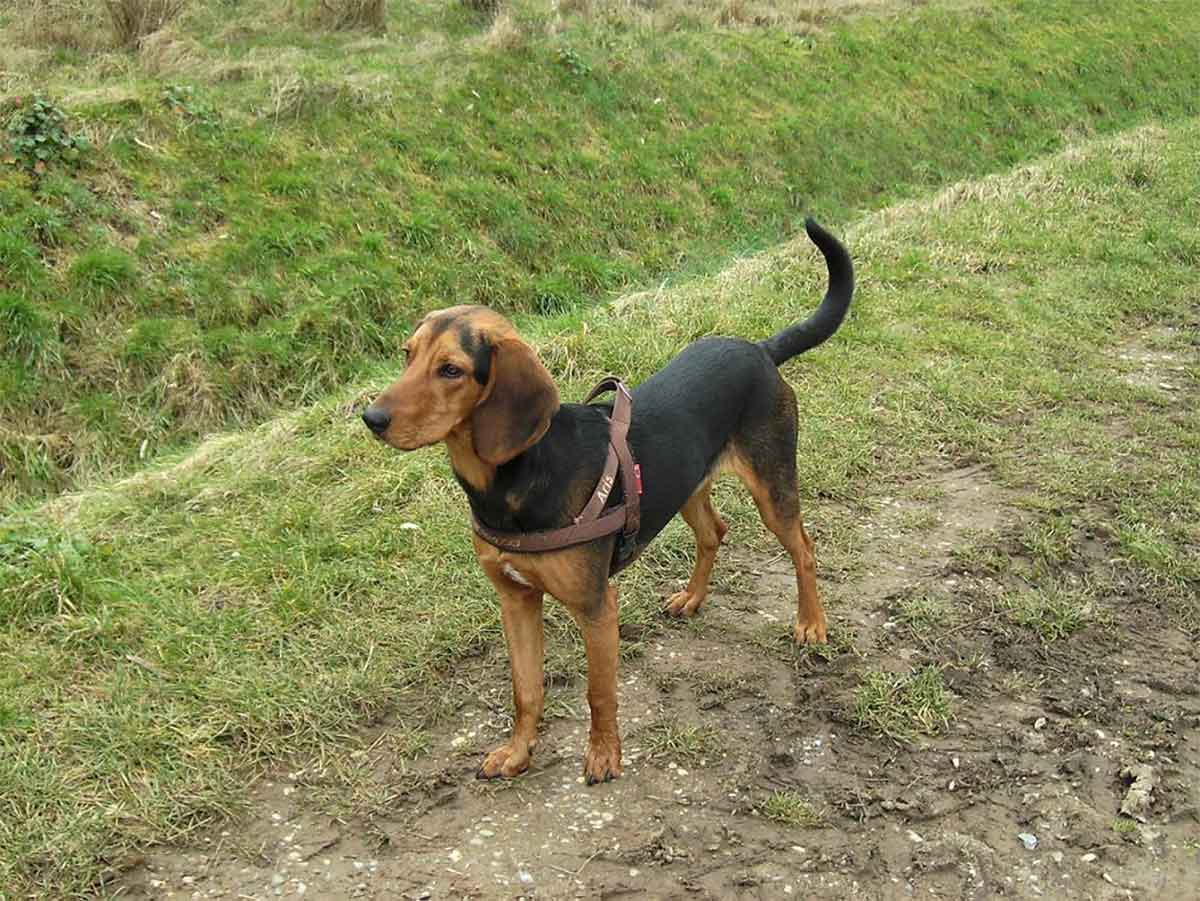
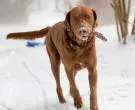
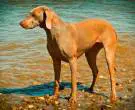
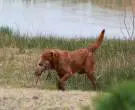
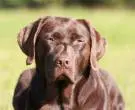

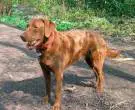



 Hellinikos Ichnilatis
Hellinikos Ichnilatis Hellinikos Ichnilatis
Hellinikos Ichnilatis Greek Hound/Hellinikos Ichnilatis at Companion Dog Test
Greek Hound/Hellinikos Ichnilatis at Companion Dog Test Bella & Felix, Greek hound , Greek Harehound , Italian Hound , Hellinikos Ichnilatis
Bella & Felix, Greek hound , Greek Harehound , Italian Hound , Hellinikos Ichnilatis